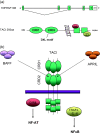Translational mini-review series on immunodeficiency: molecular defects in common variable immunodeficiency
- PMID: 17697196
- PMCID: PMC2219326
- DOI: 10.1111/j.1365-2249.2007.03461.x
Translational mini-review series on immunodeficiency: molecular defects in common variable immunodeficiency
Abstract
Common variable immunodeficiency (CVID) is a primary immunodeficiency that typically affects adults and is characterized by abnormalities of quantative and qualitative humoral function that are heterogeneous in their immunological profile and clinical manifestations. The recent identification of four monogenic defects that result in the CVID phenotype also demonstrates that the genetic basis of CVID is highly variable. Mutations in the genes encoding the tumour necrosis factor (TNF) superfamily receptors transmembrane activator and calcium-modulating ligand interactor (TACI) and B cell activation factor of the TNF family receptor (BAFF-R), CD19 and the co-stimulatory molecule inducible co-stimulator molecule (ICOS) all lead to CVID and illustrate the complex interplay required to co-ordinate an effective humoral immune response. The molecular mechanisms leading to the immune defect are still not understood clearly and particularly in the case of TACI, where a number of heterozygous mutations have been found in affected individuals, the molecular pathogenesis of disease requires further elucidation. Together these defects account for perhaps 10-15% of all cases of CVID and it is highly likely that further genetic defects will be identified.
Figures



References
-
- Cunningham-Rundles C. Physiology of Iga and Iga deficiency. J Clin Immunol. 2001;21:303–9. - PubMed
-
- Conley ME, Notarangelo LD, Etzioni A. Diagnostic criteria for primary immunodeficiencies. Representing PAGID (Pan-American Group for Immunodeficiency) and ESID (European Society for Immunodeficiencies) Clin Immunol. 1999;93:190–7. - PubMed
-
- Cunningham-Rundles C, Bodian C. Common variable immunodeficiency: clinical and immunological features of 248 patients. Clin Immunol. 1999;92:34–48. - PubMed
-
- Di Renzo M, Pasqui AL, Auteri A. Common variable immunodeficiency: a review. Clin Exp Med. 2004;3:211–17. - PubMed
-
- Warnatz K, Denz A, Drager R, et al. Severe deficiency of switched memory B cells (CD27(+) IgM(-) IgD(-) in subgroups of patients with common variable immunodeficiency: a new approach to classify a heterogeneous disease. Blood. 2002;99:1544–51. - PubMed
Publication types
MeSH terms
Substances
Grants and funding
LinkOut - more resources
Full Text Sources

